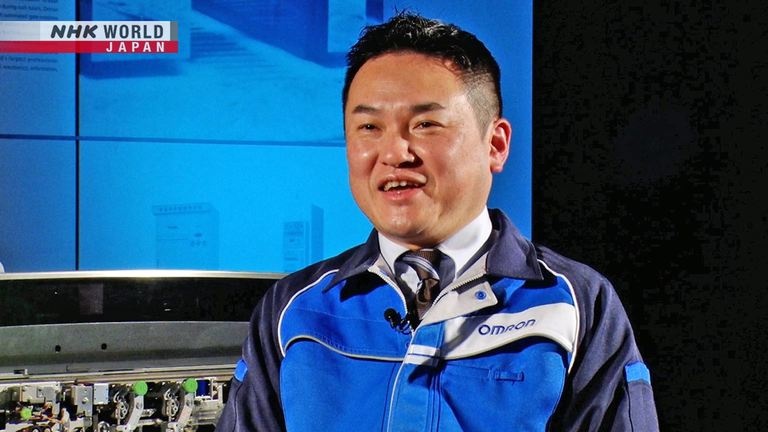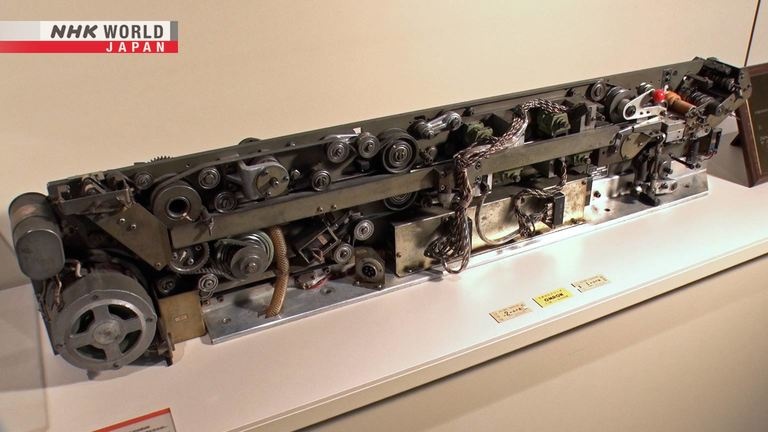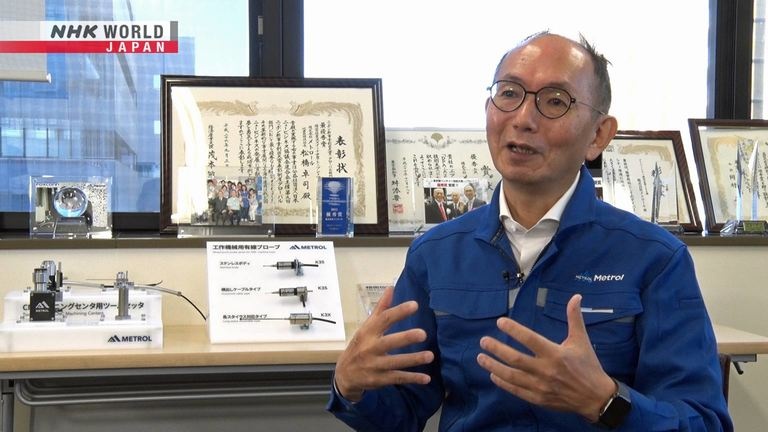Automatic Ticket Gates / Tool Setters
The fascinating stories and secrets behind hit Japanese products, plus parts and machines that boast the top share of niche markets. In the first half: the story behind automatic ticket gates, developed by a Japanese company in the 1960s and installed at train stations throughout Japan. In the second half: tool setters that can accurately measure the length of drill bits for precision machining to within one thousandth of a millimeter.



Transcript
"Japan's Top Inventions"
The behind-the-scenes tales of hit products and creations from Japan.
This is "Japan's Top Inventions."
On today's show,
automatic ticket gates found in train stations.
Tickets move through them in an instant.
The mechanism was inspired by something unexpected.
Later on the show,
a device installed in machining systems that looks like a button.
We'll reveal how they help make things accurate to the micrometer.
Hello. Welcome to "Japan's Top Inventions."
I'm your host, Jason Danielson.
In the first half of the show, we take you "Behind the Creation."
Today's topic is this.
Automatic ticket gates found in train stations across Japan.
Insert a ticket or pass,
and the machine will determine the interval and validity
before sending it out the other end.
This all happens in about 0.6 seconds,
so you can walk right through without stopping.
The first model was created over 50 years ago.
As Japan's economy rapidly developed,
extreme congestion at stations had become a problem.
But a group of engineers were ready to take on the crowds.
The showroom of an electronic equipment manufacturer in Kyoto.
The company is a leading maker of train station operation systems in Japan.
On display is a demo model that you can see inside of.
Insert a ticket,
and look at it go.
This is from an early automatic ticket gate.
Current models share this same core mechanism from 50 years ago.
It's what sends the ticket through the machine.
The device was recognized as an engineering milestone
by the Institute of Electrical and Electronics Engineers based in the US.
Our story begins in 1964.
Japan was experiencing high economic growth.
Housing developments appeared on the outskirts of cities,
and the number of morning commuters greatly increased.
The situation was of concern to a railway company in Osaka.
Station workers stood amidst the throngs of commuters, checking tickets.
The riders flashed their commuter passes.
The staff would confirm the interval and validity of each pass.
But it was a laborious task,
which was a factor in the congestion at the stations.
Could this check be automated?
An electronics equipment manufacturer in Kyoto decided to take on the issue.
At the company today is Hidaka Soshi,
who is involved in the development of the automatic ticket gates.
Here's what he heard about those times.
The engineers back then were also caught in that morning commute.
Because they experienced the congestion firsthand themselves,
they were motivated to try to do something about it.
A development team was quickly put in place.
They headed for Osaka's largest train terminal.
How many people arrived at the gate during the morning rush?
The team counted 80 people in just one minute.
From that, the goal was to create a machine
that allowed 80 people per minute through without stopping.
The team got to work immediately.
The first issue was to find a way for the machine to verify commuter passes.
The team had the idea to make the machine long.
The pass would be inserted and travel 1.3 meters to the other side.
That way, there would be time to verify the pass without stopping the flow.
But how would the machine read the information from the commuter pass?
Until then, station workers had visually checked the passes.
They needed some way for the machine to do that instead.
How could this be accomplished?
The team searched for options.
One day, they came across something.
Teleprinters, an old way to send text messages.
The devices read sequences of punched holes in paper for communication.
The team could use the same kind of holes in the commuter passes.
But things weren't so simple.
During the morning rush, 80 people approached the gates per minute.
In order for there to be no congestion,
they set a goal of 0.6 seconds
for sending a commuter pass through the machine.
The team decided to use a conveyor belt like the ones used in manufacturing.
A narrow belt would be worked into the machine.
The team tested their new conveyor belt.
But the belt couldn't withstand the speeds and snapped.
The developers kept on repeating tests.
But each time, the belt would snap.
When you run a belt at high speeds,
it rapidly stretches and contracts.
It's subject to a lot of force.
After running it for five minutes, the belt would give out and tear apart.
For two months, the development team tested
various kinds of materials for the belt.
Finally, one day,
they created a belt that could withstand the strain.
The core mechanism for sending the pass through was done.
But there was nothing to prevent someone from just walking through the gate.
The development team decided to add sensors to the machines.
If a sensor detected someone coming through without a pass,
the gates would close.
This is footage of testing they did.
30 people were gathered, representing a variety of potential passengers.
As the tests went on,
they found a problem.
If someone had a pass but was carrying a large object,
the gates would snap shut.
It seemed the sensors incorrectly picked up the large object as a person,
and closed the gates in response.
There definitely would be people passing through carrying large objects.
So we had to carefully adjust the number of sensors
and where the sensors were located.
After much testing,
the team was able to find the right distribution of sensors,
and prevent false detections.
The machine was ready to be installed.
Three years after the initial concept,
the team had created an automatic ticket gate which read tiny holes in the paper
to determine the interval and validity of a commuter pass.
Could the machine hold up during rush hour?
The team would soon find out.
March 1967.
The first automatic ticket gate would be set up at the station
for a large housing development in the Osaka area.
7 AM. The team members held their breath
as they watched the morning rush commence.
At first, things seemed to be going smoothly.
But one hour in, an alert rang, and the gates shut.
The team opened up the machine to have a look.
They found several crumpled tickets inside.
At that time, the machine was designed to handle commuter passes only.
But after the rush hour, most people were using tickets rather than passes.
Many didn't notice it was for commuter passes only, and put their tickets in.
In order to keep things moving,
the machine would need to accept tickets as well.
But there was a problem.
Tickets were much smaller than commuter passes.
They wouldn't be able to punch holes in them for all the information.
Was there a method that would work for tickets?
One team member stumbled upon an idea.
Magnetic storage used in cassette tapes.
Music data was recorded on the magnetic material applied to the tape.
The team prepared 3,000 magnetic tickets for testing.
They inserted the tickets...
and were able to read data off them.
But then...
the alert sounded, and the gates shut.
When they opened up the machine,
they found a ticket that had gotten stuck at an angle.
Since the tickets were smaller than passes,
they could end up sideways or crooked inside the machine.
How could they keep the tickets upright in the machine?
The team searched for solutions.
But they had no promising ideas.
Then one day,
one of the team members was out fishing in the river.
As he watched the flow of the water,
something caught his eye.
A leaf.
As it floated on the surface of the water,
it ran into a rock, which spun it around.
The leaf rotated.
It made the team member think of a ticket
passing through the machine and getting spun around.
The member latched onto that simple image and came up with a possible solution.
The team member got to work
and added a roller at the front end of the machine.
Hopefully, it would work like the rock in the river.
If not, the team was out of ideas.
Nervously, he sent a ticket through sideways.
At the other end,
the ticket came out upright.
They put more tickets through sideways.
Thanks to the roller,
the tickets came out upright each time.
They finally were able to get all the tickets
to go through upright and not jam.
I think everyone felt a great sense of accomplishment.
After all that hard work,
they must have felt very fulfilled and satisfied with their accomplishment.
April 1971.
The new automatic ticket gates were installed.
Crowds of commuters passed through the gates without issue,
a smooth start to the day.
And so, the value of the automatic ticket gate became widely recognized,
and the machines were installed at stations across Japan.
How do experts view this invention?
We're joined by Umehara Jun to learn more.
Welcome to the show.
Thank you.
What was groundbreaking about the first automatic ticket gate?
In order for people to pass through smoothly,
they made the automatic ticket gates long on purpose.
The machine read the ticket information as it went through.
Before these machines existed, at Tokyo terminal stations for example,
they had a set number of workers at the gates.
Two at the entrance, and two at the exit.
Now, there's about 10 automatic gates,
and the flow of people going in and out has become very smooth.
It was really groundbreaking work.
Are there any other pieces of Japanese railway technology
that you're keeping an eye on?
Japan is very good at making trains.
It's hot and humid here, so the cars can corrode very quickly.
It also snows.
The trains have to deal with a variety of conditions.
That's led to Japan making very durable train cars.
On the systems side,
like the control system for coordinating the movement of trains,
or for adjusting the schedule when there are disturbances and delays,
these are extremely advanced in Japan.
What can Japan do to help make railways better around the world?
Japan's railway system is used by many people.
The railway industry here is good with mass transport.
The railway is also very efficient.
So Japan is in a great position to help cities overseas in developing countries
which are experiencing rapid population growth.
I think Japan can help a lot there.
It can share its technology around the world.
Thanks for joining us today. It was good speaking with you.
The pleasure was mine.
Top Niche Creations.
Our next segment is "Top Niche Creations."
From smartphones to motor vehicles,
our lives are filled with manufactured products.
The demand for precision manufacturing continues to grow
as products get smaller or more sophisticated.
A key component used in precision manufacturing is this device here.
If I push on this bit, it goes down like a button.
Just what could this be for? Let's find out.
A precision component manufacturer in Tokyo.
It's a small company of about 110 employees,
but the products that they make here are vital to machining tools.
They're used in over 70 countries and regions worldwide.
Here is one of our products.
Just what does it do?
We asked president Matsuhashi Takuji to learn more.
This is called a tool setter.
If you install this in a machining system,
your precision goes up and you avoid defects.
It lets you operate for 24 hours a day, no humans involved.
How exactly does it work?
Here is a machining system in action.
The cutting tools inside are controlled by a computer,
allowing for cuts accurate to the micrometer.
But as the cutting tools are used,
their edges and tips become worn.
This loss of precision can result in defective products.
That's where the company's tool setters come in.
The way that this piece moves up and down is what's important.
Here is actual footage of it working.
Before drilling, the tip of the bit touches the device.
Then, measurements appear on the control screen.
This number represents the length of the bit, down to a micrometer.
How was it able to determine this?
Inside the device is a plunger with another pole at the bottom.
The drill bit comes down from a set position.
The tip presses against the surface and the plunger contacts the bottom pole.
The amount the bit moves in this instant is recorded by the computer.
If the drill bit is worn down,
it travels further before the plunger and the pole meet,
revealing how short it is.
One of these drill bits has been heavily used.
At first glance, it might look the same length.
But when measured with the tool setter...
it shows that the heavily used one
is 0.142 millimeters shorter.
The tool setter is accurate to one micrometer.
This automated process helps support precision manufacturing.
It's used in the manufacturing process for computers,
automotive parts, hard drives, semiconductor manufacturing machines,
all sorts of consumer products.
You could say it's involved with every industry.
The company is known around the world for its tool setters.
It was founded in 1976.
An engineer that had worked on gastroscopes
started a company to design measurement devices.
At the time, Japan's manufacturing industry was ramping up production.
Checks for precision machining tools were done manually.
But an inquiry from a tool manufacturer led the company
to start developing their tool setters.
They wanted to automate tool setting.
They wanted a sensor that could automatically work without a human around.
Having to periodically stop the machines and get someone to check the tools
meant you were losing productivity.
You're stopping the machines,
not keeping them running.
A device for automatically measuring tools.
But the developers ran into a major issue right from the start.
In order to reduce heat and friction during operation,
a large amount of lubricant is sprayed onto the tools.
The measuring device would be set up in the same area,
so it needed to work even after being drenched in lubricant.
How would this be achieved?
They turned to the gastroscopes that the founder had worked on.
These scopes needed to work in the stomach even if they got acid on them.
Rubber was used to seal the parts.
The first tool setter they developed used the same seal technology.
When developing the gastroscopes,
getting stomach acid on the scope would break it.
So an airtight design and special type of rubber had to be used.
They were able to borrow from that design.
The device gained a reputation worldwide
for being able to withstand the harsh machining environment,
and many companies started using them.
Productivity in precision manufacturing increased tremendously.
The company then worked on this issue.
Chips of metal like this come off.
The cutting process creates tiny metal chips.
Some of these chips are only micrometers big.
If these get under the workpiece,
the workpiece gets propped up a tiny amount.
Since the piece isn't lying completely flat,
cuts become inaccurate, leading to defects.
To prevent this, the company developed a special device.
The workpiece is placed on top.
If it's flat...
you get a green light.
But if you place a thin piece of metal underneath...
it knows it's not flat, and you get a red light.
How does the device know?
This small hole holds the answer.
There's actually air coming out of it.
Here's how it works.
If there are no chips, then the air is sealed off.
But if chips are present, air comes through the gaps.
This leaking air causes a tiny change in pressure,
which a sensor picks up.
That's how it knows there's a chip present.
The company has developed over a thousand manufacturing components.
Their products are relied on around the world,
supporting precision manufacturing from behind the scenes.
If humans have to be involved in monitoring or checking,
that's a huge amount of pressure on someone.
I think that burden should be taken off people.
Repetitive work should be automated when possible.
That frees up people to think or discuss how to make things better.
This is how man and machine can coexist.
The company has been supporting precision machining worldwide
from behind the scenes.
More recently, they developed a system for checking
if a piece has been accurately processed.
Here's what it looks like.
You can see there's a little ball at the tip for probing.
This ball is able to travel around a tiny bit.
Touch the probe onto a surface you want to check,
and the device will detect slight movements with the ball
and make precise measurements.
Ultra-precise, both before and after machining.
That's all for this episode of "Japan's Top Inventions."
We'll leave you with what came next for the automatic ticket gates
from the first half of the show.
See you next time, and stay inventive!
(Over 50 years ago, automatic ticket gates transformed the daily commute.)
(They were later installed in airports, assisting with boarding.)
(This is a current model installed in a Japanese train station.)
(You can pass through just by tapping your smartphone.)
We're thinking about a machine that doesn't even require a tap.
Automatic ticket gates are going to keep improving.
We're working hard to make sure that happens.